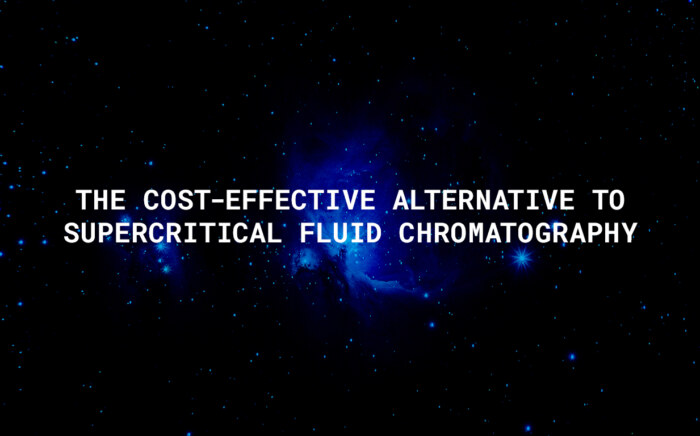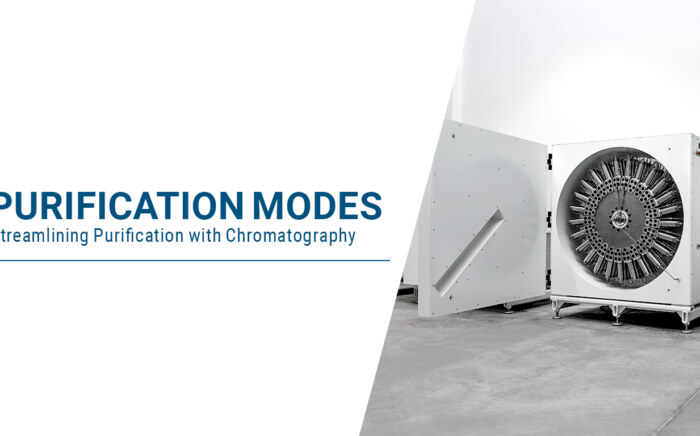Increasing separation efficiency by pH adjustment in Centrifugal Partition Chromatography
NewsSelectivity is a fundamental characteristic of all chromatographic methods and can be optimized through various parameters, including the type and strength of the organic solvent, the use of additives, the choice of stationary phase, temperature, and the pH of the mobile phase.
However, not all of these options may be feasible in every chromatographic system. In some cases, certain modifications, such as extreme pH adjustments, may temporarily improve selectivity but can lead to reduced efficiency over time or even damage the chromatographic equipment.
When the ionization state of the compound to be separated is pH-dependent, adjusting the mobile phase pH can be an effective strategy to enhance selectivity. However, this is not always practical when using silica-based stationary phases, as they are sensitive to both highly acidic and basic conditions.
Centrifugal Partition Chromatography
Liquid–liquid chromatography, including Centrifugal Partition Chromatography (CPC), offers a robust alternative to traditional solid-phase chromatography techniques, minimizing sample loss and improving compound recovery. Since both the mobile and stationary phases are liquids, the system is not susceptible to damage from extreme pH values, providing greater flexibility in method development without compromising the longevity or stability of the stationary phase.
As in other chromatographic methods, separation in CPC occurs between a stationary phase and a mobile phase. However, unlike techniques such as HPLC or SMB, the stationary phase in CPC is not silica-based but is instead a liquid. In CPC, the components to be separated are divided between two liquid phases, usually the denser lower (LP) and less dense upper phases (UP) of a two-phase solvent system. One phase function as the mobile phase, the other as the stationary phase. The designation of which phase of the two-phase solvent system acts as the stationary or mobile phase depends on the mode of operation: ascending or descending, depending on the direction of flow relative to the centrifugal force and the densities of the phases (Figure3.). The system consists of a series of interconnected cells that function as the chromatographic column. A strong centrifugal force is applied to immobilize the stationary phase within this series of cells contained in the rotor. The sample is injected at the beginning of the purification process into the immobilized stationary phase under pressure and is pumped through the stationary phase in the form of tiny droplets and elution is performed by the mobile phase using centrifugal force.

Table 1.: Comparison of the HPLC and Centrifugal Partition Chromatography
Effect of Mobile Phase pH on Silica-Based Columns
Silica-based chromatographic columns are highly sensitive to the pH of the mobile phase. At high pH levels (above 8–9), silica can undergo chemical degradation due to its inherent solubility in alkaline environments. Silica gel is an amorphous, porous form of silicon dioxide (SiO₂), consisting of a three-dimensional network of Si–O–Si bonds. It can dissolve in alkaline conditions due to the breakdown of these bonds by hydroxide ions, resulting in structural breakdown and loss of surface area.
If the stationary phase contains bonded functional groups (such as C18 alkyl chains), alkaline conditions can cause these groups to detach from the silica surface, which significantly reduces the selectivity and efficiency of the column.
Similarly, at low pH levels (below 2–3), the hydrolysis of bonded functional groups can occur. This process alters the surface chemistry of the stationary phase and may negatively impact retention behavior and separation quality.
Exposure to mobile phases with extremely high or low pH can lead to:
- Degradation of the silica matrix, altering the surface chemistry and affecting interactions between analytes and the stationary phase, which may result in poor retention and reduced separation quality.
- Irregular flow paths, which can cause increased backpressure and potentially damage the chromatographic system.
- Accelerated wear and tear, shortening the lifespan of the column and leading to more frequent replacements, increasing maintenance costs.
To maintain column performance and longevity, it is crucial to operate within the recommended pH range specified by the manufacturer, typically between pH 2 and 8 for standard silica-based columns.In the case of CPC, the liquid stationary phase means that these problems do not arise.
Advantage of CPC: pH of both phases can be adjusted over a wide range
pH-Zone Refining Mode in Centrifugal Partition Chromatography (CPC)
One of the specialized operating modes of Centrifugal Partition Chromatography (CPC) that enables high selectivity through pH manipulation of both the mobile and stationary phases is the pH-zone refining mode. This technique is particularly useful for the purification of compounds whose electric charge depends on pH, such as organic acids and bases. It allows for the separation of such compounds into a series of highly concentrated, rectangular-shaped peaks with minimal overlap, which elute according to their pKa values and hydrophobicities.
pH-zone refining CPC is a preparative separation method that employs a retainer (a strong acid or base) in the stationary phase to hold acidic or basic analytes, and a displacer (a weaker base or acid) in the mobile phase to elute analytes in order of their pKa and hydrophobicity. This method has been effectively applied to the separation of various ionizable compounds, such as amino acid derivatives and hydroxyxanthene dyes.
The principle of this technique is based on controlled pH zones established through the use of the retainer and displacer. The retainer sets a stable pH environment in the stationary phase, while the displacer, present in the mobile phase, gradually shifts the pH, creating a moving boundary that drives the selective elution of analytes.
For instance, in a descending mode operation, a mixture of free bases is injected into the organic stationary phase along with a stronger base (the retainer). An acidic aqueous mobile phase, containing the displacer, is then pumped through the system. As the mobile phase progresses, analytes elute as salts, forming well-resolved peaks. In this configuration, the denser aqueous lower phase (LP) serves as the mobile phase, while the organic upper phase (UP) remains stationary. The pKa of the retainer must be higher than that of the target analytes to maintain a stable pH gradient.
Separation of organic acids or their salts works similarly but with reversed polarity in the retainer/displacer system. This method is ideally suited for ionizable solutes that exhibit a strong polarity difference between their neutral and ionized forms, such as alkaloids, carboxylic acids, and polypeptides.
It is important to distinguish pH-zone refining from traditional displacement chromatography. Although both use a displacer-type mechanism, their functions differ: in pH-zone refining, the retainer promotes analyte migration from the mobile phase into the stationary phase at the leading edge of the band, while in classic displacement chromatography, the displacer pushes analytes out of the stationary phase to the mobile phase at the trailing edge.
The pH-zone refining method offers several advantages:
- High sample loading capacity,
- High purity and concentration of collected fractions,
- Compatibility with both ascending and descending CPC modes,
- Minimal stationary phase degradation, even under extreme pH conditions.
- The method has benne successfully used for the separation of wide variety of natural products e.g.: alkaloids, structural and geometrical isomers, acidic and basic amino acid derivatives, synthetic colors and chiral compounds.
Overall, pH-zone refining CPC is a powerful technique for preparative separations of ionizable compounds and provides a versatile alternative to silica-based chromatography systems, especially when high selectivity and robustness are required.
A major advantage of CPC, due to its liquid stationary phase, is that the high or low pH of the mobile phase does not damage the stationary phase, thus does not reducing the lifetime of the equipment and the efficiency of the chromatographic method. An additional advantage is that the list of operating modes can be further extended with the pH-zone refining mode. In this mode, the pH of the mobile and the stationary phase can be changed within a single chromatographic method. The pH change does not damage the stationary phase and higher selectivity can be achieved for specific components. The method has been successfully used for the separation of a wide variety of natural products, alkaloids, structural and geometrical isomers, acidic and basic amino acid derivatives, synthetic colors and chiral compounds. The sample loading capacity could be increasing more than 10-fold than the conventional CPC method, and high purity and high concentration of fractions could be reach.
As the stationary phase is liquid, it has many advantages:
- No silica required:
-
- More cost-effective and reusable.
- Easier and faster regeneration of the stationary phase.
- No irreversible adsorption or sample denaturation → minimizes sample loss and improves recovery of valuable compounds.
- Gentle separation technique:
CPC enables the separation of fragile compounds, as there is no risk of irreversible adsorption or chemical interaction with a solid support. - High tolerance for complex matrices:
CPC can handle large quantities of complex sample mixtures without concerns such as column fouling or “poisoning,” which are common in solid-phase chromatography. - Broad industrial applicability:
CPC is highly versatile and useful across multiple industries, including biotechnology, pharmaceuticals, and natural product extraction. - Solvent system recyclability:
The use of recyclable solvent systems makes CPC cost-efficient (lower OPEX), environmentally friendly, and aligned with green chemistry principles. - Wide compound compatibility:
Suitable for separating a diverse range of compounds, from highly polar substances (e.g., proteins) to non-polar ones (e.g., lipids). - Ideal for preparative-scale separation:
CPC supports high mass loading, making it advantageous over silica-based chromatography for preparative purposes. - Multiple operating modes available:
Offers flexibility with various operation strategies, such as ascending, descending, or pH-zone refining. - Flexible method development:
The method development process involves selecting and adjusting solvent systems to match specific separation objectives. Both stationary and mobile phases can be tailored accordingly. - pH stability:
The liquid stationary phase is not affected by extreme pH values of the mobile phase, ensuring consistent performance and extended column life.
Bibliography
- Viano, L. Milani, R. Orkenyi and A. Adamo;2023 Continuous Separation and Purification of Chemical Species by Continuous Liqui-Liquid Partition Chromatography Implemented with Membrane-Based Phase Separators Organic Process & Development, 27, 2296-2308
- Kotland, S. Chollet, J. Autret, C. Diard, L. Marchal, J. Renault; 2015Modeling pH-zone refining countercurrent chromatography: A dynamic approach; Journal of Chromatography A Volume 1391,, Pages 80-87
- Maurya, S. K. Srivastava-2009; Large-scale separation of clavine alkaloids from Ipomoea muricata by pH-zone-refining centrifugal partition chromatography; Journal of Chromatography B, 877 1732–1736
- Kotlanda, S. Chollet , C. Diardc, J.-M. Autret c, J. Meucci, J-H. Renault, L. Marchal; 2016; Industrial case study on alkaloids purification by pH-zone refining centrifugal partition chromatography; Journal of Chromatography A; Volume 1474, Pages 59-70
- Y. Ito, Y. Ma; 1994; pH-Zone-refining counter-current chromatography: a displacement mode applied to separation of dinitrophenyl amino acids; Journal of Chromatography A, 672, 101-108



